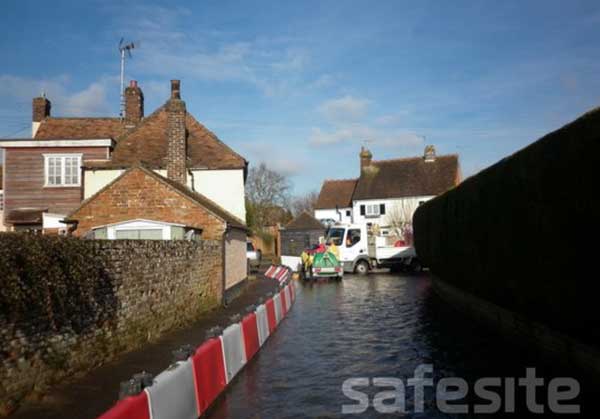This summer has been associated with record temperatures, hosepipe bans and declared drought.
Flooding might seem to be the last area of current concern, but that would be wrong; flood tends to follow drought. "The War Office is always preparing for the last war", wrote Churchill in The Gathering Storm. Time to start thinking about the next problem, not the last one.
Why flood follows drought
There are three main types of flood. Fluvial floods occur when the water in a river or lake rises and overflows into the surrounding land. Coastal floods, also known as storm surges, are inundations of seawater into coastal land, typically after storms. Pluvial floods, also known as flash floods, are events where the rainfall exceeds the ability of the soil to absorb moisture, meaning surface water spreads laterally. Scientists expect flash floods especially to get worse in both quantity and severity, because of climate change: for every additional one degree Celsius, water vapor in the atmosphere increases by 7%, meaning more rain. And, of course, rain and sea level change affects other type of flood too: the US government website climate.gov notes that sea level has risen 91 mm since 1993, that the rate of rise is increasing, and that in many locations, "high-tide flooding is now 300% to more than 900% more frequent than it was 50 years ago".
Drought doesn’t cause the rain, but it does bake the soil into an impermeable surface, meaning water doesn’t vanish into the earth. With any sort of flood, but especially flash floods, a harder ground surface increases the probability and severity of flooding. Watch this 60-second video from the Guardian to see the concept demonstrated.
Am I at risk from flooding?
Fortunately, the UK government has a tool you can use to check your level of flood risk. This link is for England, but go there also for further links to check flood risk throughout the UK. The Northern Ireland tool takes a somewhat harder to use flood map approach, but the other tools break down risk very simply for any address, assessing surface water risk (i.e., flash flooding) separately from other forms of flooding, as well as offering the detailed flood maps. Other governments offer similar resources.
What do I have to do to prepare for flooding
If you are a developer, flood risk assessment for the proposed development is, of course, part of the planning application process. This is quite separate from keeping your site safe while you build.
As for protecting your site during construction, use the government tools discussed above to check your risk. You may also wish to email the Environment Agency and ask for the flood history of the site. Unless you’re satisfied that risks are low, develop a formal flood plan and an evacuation plan, and sign up for free flood alerts from GOV.UK and the Met Office. Download a flood plan template here and read general government advice to businesses on flood preparation here.
Look at the geography of your site to decide how much drainage there is, and whether it would be useful to invest in pumps and train staff in their use. If you operate a pump, go here to see if you’ll need an environmental permit for that.
Don’t let standing water build up; if there are large puddles on your site, always deal with them right away, because they may build into an avoidable flood. In cold weather, run water through pipes periodically even if you’re not using them for anything. This can stop cold water turning to ice.
The Health and Safety Executive generally advises that sites should be clear and tidy, with structures and trenches safe from collapse. Heed that advice.
What do I do after an alert or flood?
If you get a flood alert, move equipment and materials to somewhere higher or safer. Be sure to have thought in advance about how you will move dangerous items such as chemicals. Ideally, store them in somewhere flood-safe at all times. Turn off utilities and unplug equipment. If you’re wet or standing in water, flip any electrical switches or fuses with a dry stick. Take before and after photos for insurance purposes.
Avoid contact with water wherever possible, as it may have become contaminated with sewage, droppings or chemicals. Definitely don’t wade into water – other risks here include stepping onto sharp objects or uncovered drains. Be aware that most flood deaths are due to people driving vehicles into water that turns out to be deeper than they thought.
The days of sandbags as the best flood defence are over. Modern flood barriers interconnect to form a solid barrier, self-filling with the floodwater itself to become stable. Go here for an example of such barriers. Companies can install this protection quickly after you receive an alert. If risk is high, though, you may wish to install such defences in advance. Whoever you source barriers from can likely help in other ways, for example providing ground protection matting to turn a muddy surface into a safe walkway. Using those mats from the start of construction stops people and machinery breaking up the ground and encouraging mud formation.
Time and date
CONSTRUCTION DIRECTORY
Construction News
03/10/2022
A Hard Rain: Preparing Your Construction Site For Flood After Drought

Latest Construction News
15/11/2024
A significant redevelopment is underway at Royal Naval Air Station (RNAS) Culdrose, Cornwall, following a contract award to Kier and Mott MacDonald. The Defence Infrastructure Organisation (DIO) and the Royal Navy marked the occasion with a contract-signing and ground-breaking ceremony, ...
15/11/2024
JV North, a consortium of housing associations and local authorities, has unveiled a new £500 million procurement framework aimed at delivering over 3,000 affordable homes between 2025 and 2029. The initiative marks a significant boost for social housing and the construction sector. The ...
15/11/2024
Sempra Homes has announced funding approval for a new affordable housing project at Bowers Close on London Road, Pitsea. The development will deliver 31 high-quality homes, offering a mix of rental and shared ownership properties designed to address local housing needs. The project has received ...
15/11/2024
Vistry Group has received planning permission for the first phase of its Wolborough Grange development, which will deliver 94 high-quality homes. This milestone marks the beginning of a transformative project that will provide sustainable housing and significant community benefits in Newton ...
15/11/2024
Salisbury Coach Park and the main footpaths through the Central Car Park have reopened following an extensive transformation by the Environment Agency as part of the River Park scheme. The upgraded facilities aim to provide a more welcoming and comfortable experience for coach passengers visiting ...
15/11/2024
Pennyfarthing Homes has unveiled an exceptional collection of one- and two-bedroom apartments at Oakwood Grove, a modern development offering affordable homes through the Government-backed First Homes scheme, now available via Dorset Council. Located in the scenic rural village of Alderholt, ...
15/11/2024
Morris & Spottiswood Group has acquired part of the collapsed ISG group, offering a vital lifeline to the employees and projects operating within its remit. Absorbing the former ISG Cathedral business, Morris & Spottiswood Group, which is a specialist provider of fitout, refurbishment, M&E, ...
15/11/2024
Morgan Sindall Construction has officially commenced work on Rosherville Church of England Academy, a new primary school designed to address the educational needs of Northfleet’s expanding community. To commemorate the start of the project, a time capsule was ceremonially lowered into the ground, ...
15/11/2024
Vistry Group has exchanged contracts to develop over 200 mixed-tenure homes at Waggons Way, Doncaster. The 16-acre site, formerly part of the Hatfield Colliery, will be transformed into a vibrant new community featuring up to 236 high-quality homes. The proposed development will include homes ...
15/11/2024
The University of Sunderland has officially relaunched its newly refurbished cinema. The venue on St. Peter's Campus was damaged beyond use due to Storm Arwen in 2021, but now a £1.3m investment means it is back in action once again. To mark the occasion, Sir David Bell, the University’s ...

















